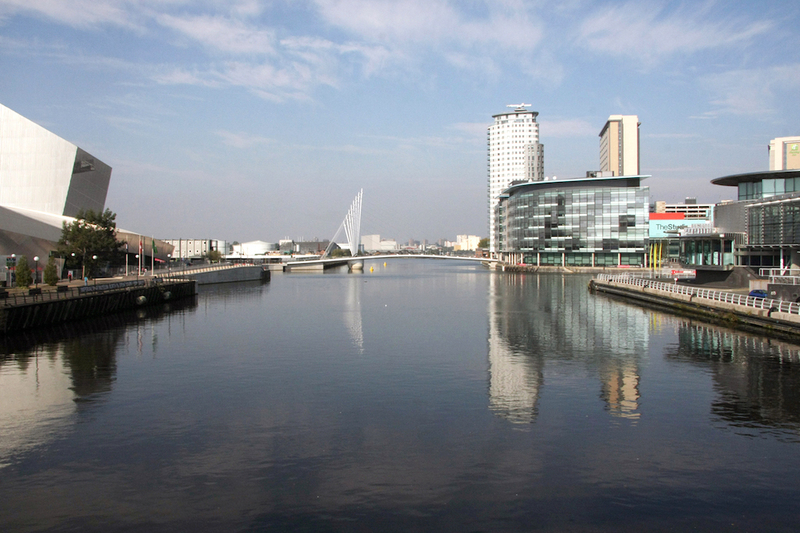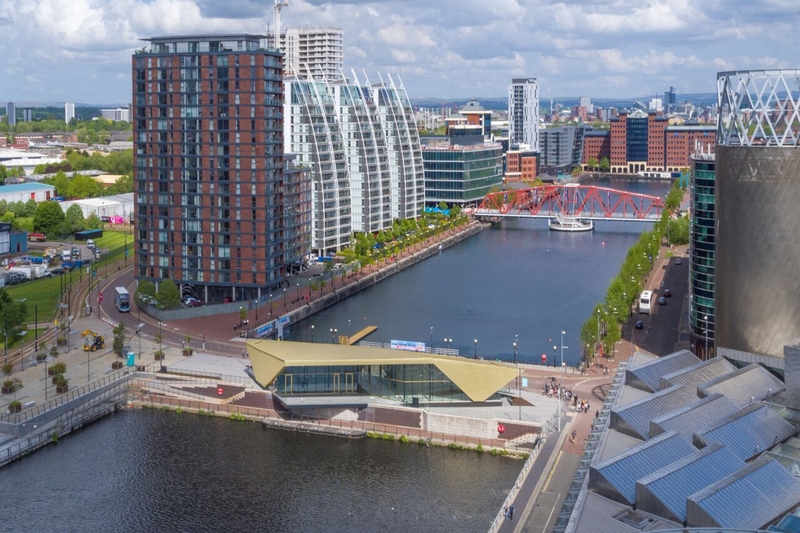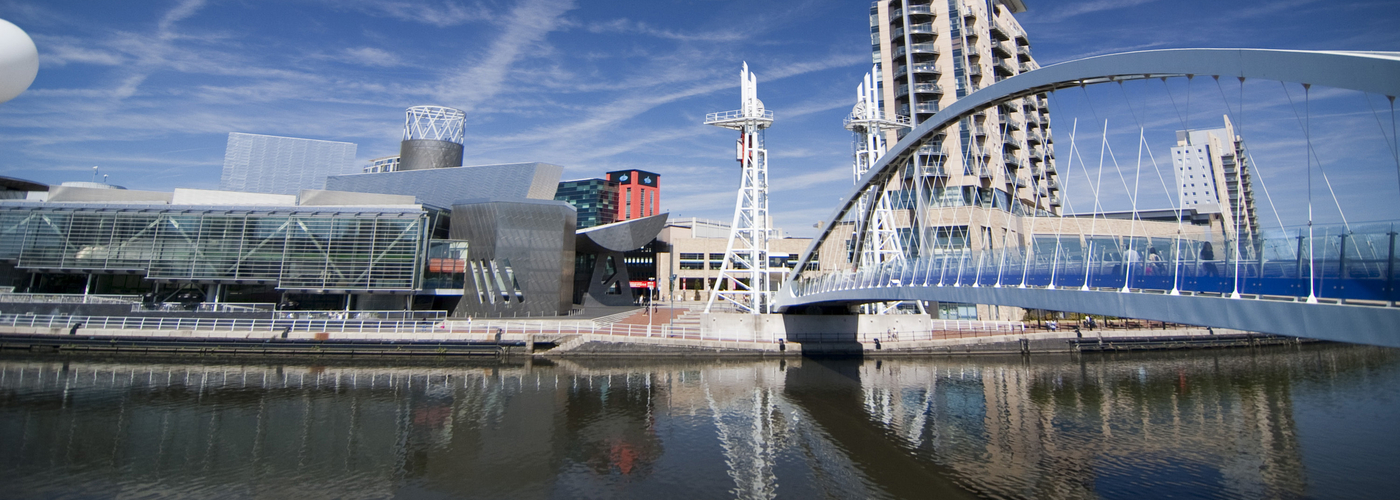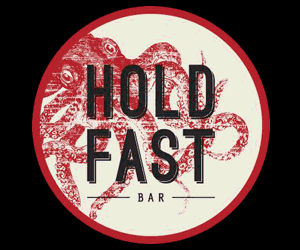Jonathan Schofield takes you for a waterside wander
THE QUAYS, formerly Manchester Docks, makes for a fine circular walk of around twenty minutes without stops, but you’ll want to stop and you’ll want to visit buildings. The architecture, the engineering and the huge expanse of water creates a spectacular modern urban landscape. Not all the buildings are classics, but the combined effect is powerful. Sport even joins in with Old Trafford football stadium closing off the view to the south.
A bonus is the quality of the light as it bounces off the water and ricochets off the steel and aluminium buildings. Dawns and sunsets are often stunning, but beware the wind that can come howling down Manchester Ship Canal. The lighting scheme across the Quays makes an evening walk rewarding too. The easiest way to access the area is by tram from the city centre to the MediaCityUK Metrolink station.
Start the walk at The Lowry arts centre and cross the footbridge nearby. This was finished in 2000 to the designs of Casado of Madrid. It was engineered by Parkman’s of Salford and constructed a short distance down the canal at the dry dock on the other side of the Imperial War Museum North. It was then floated into place. It is a lift bridge, the whole walking area lifting in its cat’s cradle of wire and steel, around 20m (65ft) or so, to the great pulley wheels on the four pylons. In the summer months Mersey Ferries from Liverpool travel up and down the canal and the bridge opens to let the vessels through.
Standing in the centre of the bridge, the view encompasses the Imperial War Museum North, The Lowry, the city centre, Manchester United Football Club and in the distance the Pennine hills. Turn left after the bridge to view the artworks, there’s a small playground too.
The best of the works is the furthest away, Silent Cargoes by SITE. This commemorates the canal and the adjacent area of Trafford Park which it served. The artwork takes the form of an arrangement of industrial artefacts and products, machinery, tools, barrels, cotton bales seemingly abandoned on the wharf side. Scattered through the work are gloves and caps, as though the workers have just come off shift. This gives the work an air of melancholy. The industrial world might have been mucky but there was an honour in manufacturing which is less easy to discern in a nation increasingly employed in the service industries.
Retrace your steps, but at the bridge continue on this side of the canal to the Imperial War Museum North (IWMN). If the museum is open, walk round the building to get a feel for this unusual structure, before entering at the main entrance, on the other side of the building away from the canal. IWMN was designed by Daniel Libeskind and opened in 2001.
Prior to working in Trafford he built the Jewish Museum in Berlin, subsequently he has worked on the masterplan for the World Trade Center site in New York following the terrorist attack on September 11, 2002. Libeskind’s buildings are all about statement and concept. For the Imperial War Museum North Libeskind placed a ceramic tea pot in a plastic bag and dropped it out of the window. Three of the broken shards he arranged as a world shattered by war in a pattern representing the three theatres of land, sea and air war. The resulting building is deliberately disorientating with few right angles or level floor plates, thus reflecting the confusion of war.
The stories told are very moving, the exhibits can be terrifying
The main permanent exhibition lies in the Earth Shard. The exhibition areas here, the ‘silos’, provide a blank canvas for the light and sound shows that regularly transform the space. The message of the museum is stated as 'War Shapes Lives'. This is delivered without judgment, the facts and stories laid before visitors, and covers conflict since WW1. The exhibits come from the Imperial War Museum’s own collections. The stories told are very moving, the exhibits can be terrifying. A nuclear bomb seems modest in size, perhaps a couple of metres long, the map on the wall nearby shows you the large area of Northern England it would have devastated were it to have been dropped.
Libeskind’s connection to the World Trade Center site has an echo in the 7m (23ft) section of twisted steel from the toppled buildings. The pick of the artworks is Gerry Judah’s Crusader, a beautiful large white sculpture contrasting with the darkness of the subject matter which depicts destroyed buildings on a cross. The temporary exhibitions are always worth visiting and there are plenty of activities for kids and of course, a cafe and a shop.
The excellent landscaping on the canal side of IWMN leads to the second footbridge. This was finished in 2011 and was designed by Gifford Engineering and Wilkinson Eyre. It weighs 450 tonnes, and has two spans of 65m (213ft) and 18m (63ft). It swings through 71 degrees to give a 48m (158ft) navigation channel.
On the same side of the canal as IWMN is ITV Granada with hints - over the modest facade as you cross the bridge - of the set of the longest continuously running TV soap anywhere, Coronation Street. This began in December 1960, written by Tony Warren and based on working class life in the streets of nearby Ordsall.
The footbridge takes you into the heart of MediaCityUK, the nation’s largest concentration of media, principally occupied by almost 2,500 BBC staff, who started to arrive in 2011. The first building on the right is Quay House, which broadcasts BBC Breakfast, Match of the Day, BBC Radio 5 Live, North West Tonight and BBC Radio Manchester. On the left is Bridge House where Blue Peter, Mastermind, Dragons’ Den, CBBC, and BBC Bitesize are produced.

The route from the bridge opens out into the main square of MediaCityUK with its large screen. The dominant building is The Studios with its varied colour scheme. This contains seven high definition studios, the largest with an area of 1,160m2 (12,500sqft). One of the studios is occupied by the BBC Philharmonic Orchestra and sat on hydraulic jacks to insulate it from noise coming from other studios. The next building along, facing the superb small park, is Dock House and contains the BBC’s Research and Development, Religion and Ethics departments and BBC 6 Music. Several Radio 4 programmes are also made here.
Orange House, next door, contains several restaurants, more ITV space and the University of Salford’s media departments. There are several apartment blocks behind the media buildings. The BBC moved many of their departments to the banks of Manchester Ship Canal in an effort to lessen the London-centric metropolitan tone of their output. It’s cheaper to be here than in the capital as well.
The whirlpools have worked so well there are open water swimming sessions in Dock Nine
The architecture of MediaCityUK from Wilkinson Eyre, Chapman Taylor and Fairhursts has been criticised as a ‘crazed accumulation of development, in which every aimlessly gesticulating building sports at least three different cladding treatments. The overriding sense is one of extreme anxiety on the part of the architects about the development’s isolation’. You can see what Ellis Woodman, the writer of this, meant and that might have seemed the case in 2011.
Now, in 2018, MediaCityUK can be appreciated much better. With a playground in view across the Quays to IWMN, the small park, plus the Blue Peter garden, the area has become popular with locals and visitors, especially families. The Dockyard pub selling Manchester beers and simple food has also helped to bring visitors in.
Walk through the park area to the main road and turn right. On the left is the long expanse of Dock Nine, bordered by apartments and at the far end several shoddy examples of 1980s commercial architecture. The swing bridge in the middle of the dock arm was moved here from the main canal in the ‘80s. Over half a mile in length, Dock Nine was big enough to hold ten large ships. The change in character has enabled the atrociously polluted waters to be cleaned.
The process is on-going: if you look carefully, twenty metres down Dock Nine, you might see bubbling whirlpools oxygenating the waters. These have worked so well there are open water swimming sessions in Dock Nine and an annual triathlon.
Unmissable here is the Alchemist bar, a golden ark of a building with a fine terrace on the western side. Straight ahead is the shiny steel of The Lowry. Walk towards the building and then turn left to circumnavigate it. At the far end is the artwork Where the Wild Things Were by Unusual Artists (that’s their name). The idea is that the giant blades of elephant grass ‘suggest places beyond the canal, where ships sailed to and from’.

Continue round the far side of The Lowry and underneath the footbridge and along the promenade facing Manchester United on its ridge over the canal. The promenade leads to the Helly Hansen Watersports Centre where visitors can partake of dinghy sailing, windsurfing, wakeboarding and power boating.
Retrace your steps with the Lowry Outlet Mall on the right, back to The Lowry arts centre. This stainless steel building was designed by Michael Wilford and comprises theatres, an art gallery, a restaurant, a shop, conference areas and Salford Tourist Information Centre.
The colours are overwhelming, oranges and deep purples...
It opened in 2000 and kickstarted the proper redevelopment of the Quays and attracts several hundred thousand people each year. The Lyric theatre has 1,750 seats, the Quays, 460. There’s a smaller Studio for 150 too. The exterior of the main auditorium rises in steel panels above a mass of sharp geometric forms, cones, cubes and circles. These are swathed in glass allowing a view of people circulating around the interior. The view from the inside out is good while the views across the building are remarkable. The foyer is overlooked by balconies opening from the first floor, and the restaurant bar is crossed by a bridge whilst the outer shell of the Lyric is punctured by balconies and staircases. The colours are overwhelming, oranges and deep purples in the entrance area, in stark contrast to the silver exterior.
Wilford wanted this building to be very democratic, appealing to everyone, and he thought the colour scheme aided this. The galleries devoted to Manchester artist Laurence Stephen Lowry, and to temporary and visiting exhibitions, are on the north facing side of the building to prevent damage from the sunny south, but there is plenty of light streaming in from the neighbouring promenade windows.
There’s irony with the dedication of this building to Lowry. A space that is as colourful as an HG Wells’ dream of the future commemorates an artist who inhabited a hermit’s cave of imagination. A building that attracts thousands to its shows marks a man who shied from human relationships. Meanwhile the industrial scenes Lowry painted have disappeared outside his dedicated art centre under apartments, shopping centres and studios.
The whole reason for the Quays is, of course, Manchester Ship Canal. Here’s a potted history. In 1882 Daniel Adamson, an eminent Manchester engineer, organised a campaign for the construction of a canal to allow ocean-going traffic to sail inland as far as the city.
In 1885 Parliament approved the Ship Canal Act, despite strong opposition from Liverpool Docks and the railway companies. It was these bodies which had fuelled the impulse for the canal through the tariffs they imposed on Manchester products. It had cost 19s 3d to send a ton of finished cotton from Manchester to Calcutta in 1856, of which 12s 6d was incurred getting it out of Liverpool.
Manchester Ship Canal was the largest single engineering project undertaken in 19th century Britain. It took more than 16,000 navvies six years to excavate the 56km, eight metre deep canal. Opened by Queen Victoria in 1894, the trade the canal generated together with the large industrial area of Trafford Park, which grew along the south bank, helped bolster Manchester industry for decades. At one point Manchester was the third largest port in the UK by tonnage despite its distance from the sea.
The headwaters became redundant as container vessels grew too large. The last commercial visit to the headwaters was in 1982 although large ships still arrive at the grain works and scrap yard a couple of kilometres further down the canal. Manchester Ship Canal company was during construction publicly funded with Manchester taxpayers’ money.
After acquiring a majority share holding as the canal declined in the 1970s and 1980s a private company, now called Peel Group, bought the remaining shares. They have developed schemes on the vast property holding of the Ship Canal such as MediaCityUK, The Trafford Centre and the AJ Bell Salford Stadium.
Epic engineering mostly designed by Sir Edward Leader Williams remains from the original construction along the length of the canal, such as Barton Aqueduct which swings 800 tons of water in the Bridgewater Canal over Manchester Ship Canal to allow passage of ships. The bridges and locks such as Irlam High Line Bridge are equally impressive.
Here at the Quays the central Manchester area has been fortunate. They give Manchester a rich bonus in terms of tourism. No other UK inland city has anything like The Quays. The scale means it never fails to impress, and, of course, the best way to enjoy the light, the scale and the water is to walk it.
Enjoy that? Well, how about this... The Impossible Bridge And The Improbable Hill: Irk Valley Tour














